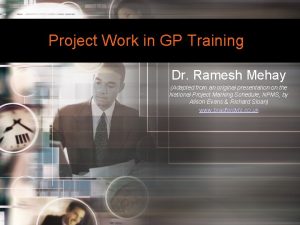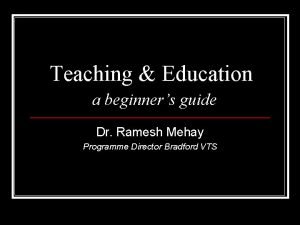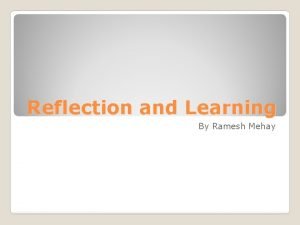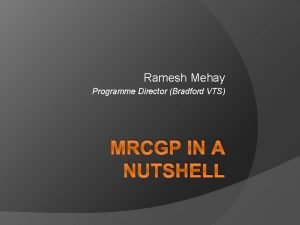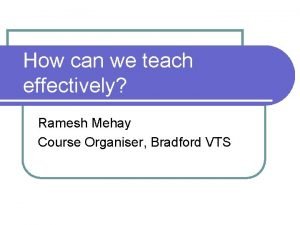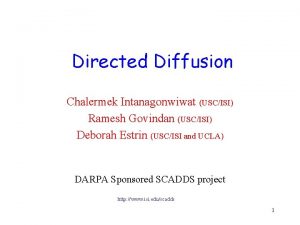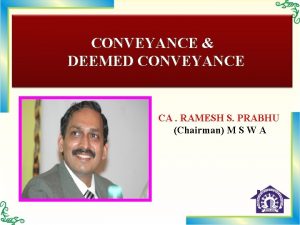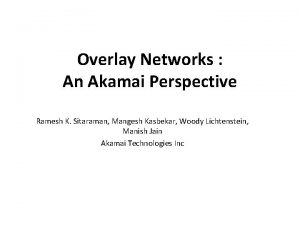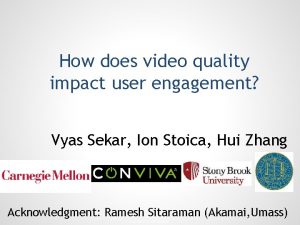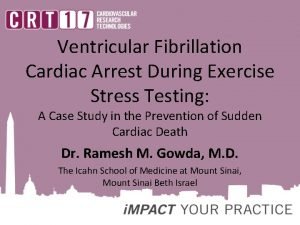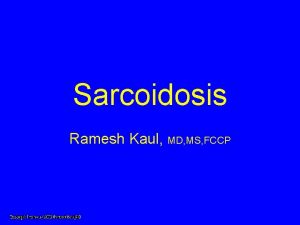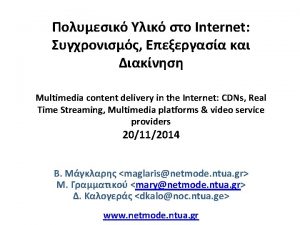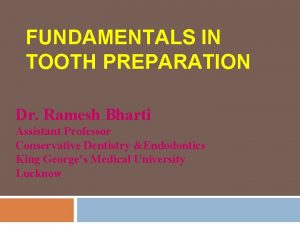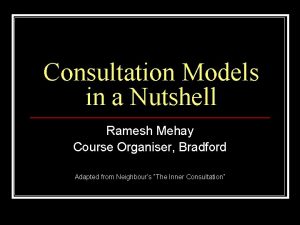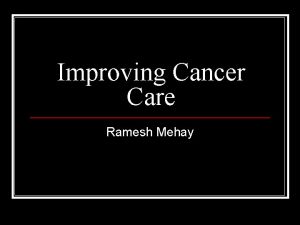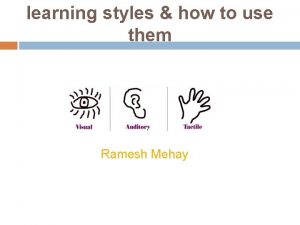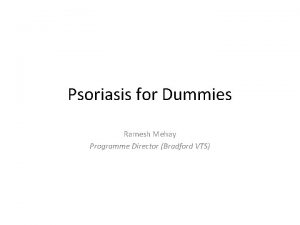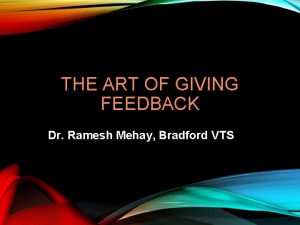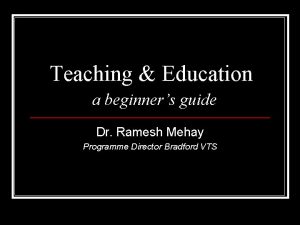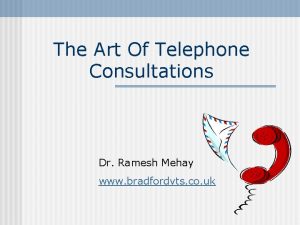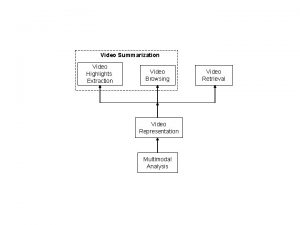Gask Video Analysis Dr Ramesh Mehay Course Organiser






















- Slides: 22

Gask Video Analysis Dr. Ramesh Mehay Course Organiser (Bradford VTS) www. bradfordvts. co. uk

AIMS • To highlight the emotional issues that MUST be addressed in a consultation (GASK) This slide show has slide notes that you may wish to refer to

OBJECTIVES GASK: • To improve your Problem Detection Skills (beginning the consultation, picking up and responding to verbal and non verbal cues, demonstrating empathy, asking about health beliefs/concerns, ending the consultation) • To Improve your Problem Management Skills (ventilating feelings, information giving/educating, making links, negotiating, motivating change, problem solving)

Key Point 1 A common first reaction to the sight of oneself on video is that you look professionally incompetent and personally unattractive – don’t worry about this. You will soon come to see yourself in a better light.

Why Do We Need Good Communication Skills? • Diagnosis • Giving Information • Giving Support

Sources of Information in the Consultation • • • What the patient says (verbal cues) What the patient does (non-verbal cues) What the doctor perceives How the doctor feels Other parties (eg in 3 way consultations)

The Gask Method After Linda Gask (Psychiatrist, Manchester) Session 1 (til 3. 15 pm)

The Gask Method • Problem Orientated Analysis for demonstrating cues or emotional content • Facilitator/Group members can stop the tape whenever they see a cue • Can also use it to demonstrate the structure as well as skills in the consultation

How the Gask Method Works • Learners select the consultation • Learners identify issues they want to focus on (agenda setting) • Focus on the tape • Anyone can stop the tape • Focus on specific skills, not generalities • Focus on consultation skills, not clinical content • Can stop the tape to draw attention to a skill which was demonstrated, or to something which could have been done differently • In the latter case, the person who stops the tape must have a specific suggestion for an alternative way of doing it

Additional Methods Consider role-playing certain issues Can use a variety of methods I. One acts as dr, one acts as pt II. Whole group acts as dr, one acts as pt

The Video Tape PLEASE REMEMBER: • The doctor on the tape is offering his/her tape “as a gift for the group” Respect that! • Think of yourself in that situation before being critical

Giving Feedback Your aim is not to destroy the other person A Balancing Act between Being Too Critical Cosiness Zone The Most Important Part of Feedback is Offering an Alternative to the Skill or Task Being Analysed

Giving Feedback So, feedback requires: • Courage • Skill • Understanding • Self Respect • RESPECT FOR OTHERS

Feedback – general principles revisited Focus on • • Behaviour which can be changed Being accurate and clear The behaviour, not the person Observation, not inference Description, not judgement sharing ideas, not giving advice Exploring alternatives, not providing answers

Feedback – general principles Also think about: • How much to give • When to give it

Feedback – Pendleton’s Rules • Clarify matters of fact • Thing that went well • How they went well Doctor first, then the group • Things that could have been done differently • How they could have been done differently Doctor first, then the group • The pair or group agree areas for development

What to look for in the Video • Look at (behaviour/skills) Performance Effects on Others • Be Aware of (tasks) What (s)he does How (s)he does it

FACILITATOR NOTES

Facilitator Notes – Gask 1 Facilitator’s roles • Monitor and facilitate discussion at each tape stop, summaries if appropriate. Make sure learner’s and group’s needs are both being attended to • Label/Identify the behaviour of the doctor on the tape and the alternative behaviours suggested by the group • Stop the tape when the patient clearly exhibits verbal and non verbal cues, if necessary prompt group to develop own skills in identifying these by asking a hierarchy of questions like: 1. “why do you think I stopped the tape there? ” 2. “Did you notice anything happening at that point? ” 3. “Did you notice anything about the patient’s voice? ” 4. “Did you notice her voice changed when she talked about her husband? ” • Make sure the group gives constructive criticism : balance between positive comments and alternative suggestions • Ask for feedback at the end from the doctor who brought the tape • Give them some praise to go home with

Facilitator Notes – Gask 2 WHAT CAN YOU TEACH WITH GASK 1 Problem Detection Skills • Beginning the consultation • Picking up/responding to verbal cues • Picking up/responding to non verbal cues • Demonstrating empathy • Asking about Health Beliefs/Concerns • End the Consultation

Facilitator Notes – Gask 3 WHAT CAN YOU TEACH WITH GASK 2 Problem Management Skills • Ventilate Feelings • Information/Education • Making Links • Negotiating • Motivating Change • Problem Solving

Facilitator Notes – Gask 4 Possible Pitfalls • First time GPR’s may tend to go for content and clinical mistakes • Encouraging role play can be difficult in both GPR 1 and GPR 2’s – don’t enforce it though, negotiate or let them decide (we don’t want to frighten them off video analysis) • Think of methods of encouraging and motivating a passive group
 Ramesh mehay
Ramesh mehay Ramesh mehay
Ramesh mehay Ramesh mehay
Ramesh mehay Bradford vts akt
Bradford vts akt Ramesh mehay
Ramesh mehay Ramesh govindan usc
Ramesh govindan usc Ramesh r. rao
Ramesh r. rao Ramesh prabhu deemed conveyance
Ramesh prabhu deemed conveyance Ramesh sitaraman
Ramesh sitaraman Ramesh sitaraman
Ramesh sitaraman Ramesh sitaraman
Ramesh sitaraman Cathvideo
Cathvideo Ramesh kaul
Ramesh kaul Introduction to angular
Introduction to angular Ramesh sitaraman
Ramesh sitaraman Initial tooth preparation stage
Initial tooth preparation stage Videos yandex 2020
Videos yandex 2020 Gravity yahoo
Gravity yahoo Videos yahoo search
Videos yahoo search The frame size of a video refers to the video’s
The frame size of a video refers to the video’s What is half brick wall
What is half brick wall Course number and title
Course number and title Course interne course externe
Course interne course externe
